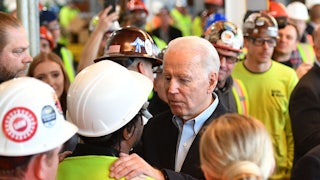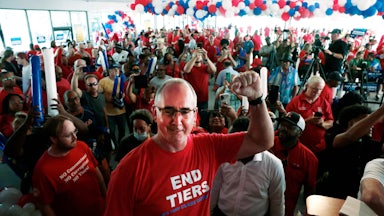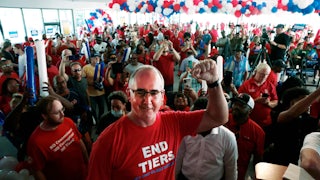The perennial complaint about mainstream media coverage of presidential elections is that it too often gets bogged down in the horse-race muck—endless discussions of approval ratings, head-to-head polls between front-runner candidates, and the public’s opinions on hot-button issues. On those rare occasions when policy is discussed, the media treats it as if we had a parliamentary system that would allow a candidate to seamlessly implement their agenda if elected. This style of political journalism might generate engagement, but it does little to actually inform voters about how a presidential candidate will actually flex their most important power—staffing and directing the executive branch.
Barring any drastic shifts in the primaries, however, the horse race is over: The 2024 general election will be a rematch of Joe Biden and Donald Trump—providing a unique opportunity to directly compare two case studies illuminating how the respective presidents led their offices. From appointments to regulation and enforcement, perhaps the starkest contrast comes by examining the two candidates’ vastly different approaches to how the federal government manages relationships between workers and employers through the National Labor Relations Board, or NLRB, and the Department of Labor. Here, there is no contest: Biden’s labor efforts were aggressively pro-worker; Trump’s were anything but.
Let’s begin at the top. The NLRB’s general counsel, which is the top job at the agency, transitioned from a rabidly pro-business attorney under Trump to a pro-labor union lawyer under Biden, leading to a dramatic sea change virtually overnight. Trump tapped Peter Robb, a management-side labor attorney at anti-worker firm Proskauer Rose, as his general counsel. Robb had an infamous past in the public sector—leading the Reagan administration’s ruthless throttling of the Professional Air Traffic Controllers Organization in one of the most flagrant attacks on workers’ rights in post–New Deal history. Much to the joy of organized labor, Biden swiftly fired Robb upon taking office and replaced him with Jennifer Abruzzo, a labor attorney boasting over 20 years of work experience at the NLRB and a stint as special counsel for the Communications Workers of America.
Robb’s NLRB was a dysfunctional mess. He repeatedly infuriated career staff by diminishing the authority of regional directors and famously disputed an Inspector General’s report that called for board member William Emanuel to recuse from a case due to a conflict of interest. On matters of policy, Robb’s board was diligently pro-business and anti-labor. The NLRB brought a lawsuit against an Oregon law that allowed workers to skip captive audience meetings held by their employers in order to spout anti-union talking points. It instituted a rule that severely limited the definition of joint-employers, thereby shielding giant firms such as McDonald’s from liability when its franchises broke the law. It reversed precedent regarding the definition of a bargaining unit, allowing employers to easily bust organizing efforts by claiming that a group of workers with different job classifications does not constitute an appropriate bargaining union. These are just a few of Robb’s greatest hits—see this report from the Economic Policy Institute for a full accounting of the disastrous policies pursued under his leadership.
With Abruzzo at the helm, the tenor of the National Labor Relations Board turned on its head. The NLRB has rolled back many Trump-era policies, namely the joint-employer rule and the “overwhelming community of interest” standard for bargaining units. Abruzzo, however, has not been satisfied with simply reversing and unwinding the previous administration’s anti-labor policies. Her NLRB picks fights with powerful corporations and challenges policies that have held back workers’ rights for decades. Under her stewardship, the NLRB has been fearless in protecting the right to organize by issuing injunctions against corporations that violate those rights—Starbucks, Amazon, and UPS have all been on the receiving end of such orders. The agency’s top brass has shown an eagerness to reverse course on long-standing policies that hindered union organizing—exemplified by Abruzzo’s first memo to NLRB attorneys, which called on them to pursue cases that could restore the Joy Silk doctrine.
The Joy Silk doctrine was a board policy from 1949 to 1969 that required employers to recognize and bargain with a union when a majority of workers signed cards to join, barring any “good faith doubt” that there was a majority. The NLRB abandoned Joy Silk in favor of the Gissel doctrine, which allowed employers to refuse to recognize a union and demand a formal election conducted by the NLRB. Employers used the waiting period before an NLRB election to engage in union busting, often committing unfair labor practices—for example, threatening to fire employees who vote for a union—that undermine a worker’s likelihood of joining the union.
Abruzzo hasn’t quite succeeded in reinstituting Joy Silk, but she came close with last year’s Cemex case, in which the NLRB ruled if an employer was found to have engaged in any unfair labor practices in the run-up to an NLRB election, the employer would be forced to recognize and bargain with the union. Reactions to Cemex are a microcosm of the contrast between the Trump and Biden administrations—vitriol from the Chamber of Commerce, the Federalist Society, and trade associations; praise by unions who see it as a landmark victory for workers.
At the Department of Labor, Trump’s nominees were a carousel of lackeys with one qualifying trait in common: a disdain for any policy that helped workers live better lives. The first pick for secretary of labor was Alexander Pudzer, a heavyweight campaign donor and CEO of the fast-food conglomerate CKE Restaurants. When he wasn’t busy overseeing fast-food chains that were routinely fined by the department’s Wage and Hour Division, he found time to criticize the Obama administration for expanding eligibility for overtime pay, instituting paid sick leave for contractors, and attempting to raise the minimum wage. Pudzer’s nomination fell through—alas, not because he was fundamentally opposed to the Labor Department’s mission but due to a series of scandals, including the fact that he personally employed an undocumented housekeeper, racked up several domestic violence accusations from his ex-wife, and outsourced jobs to the Philippines.
With Pudzer’s nomination up in flames, Trump turned to Alexander Acosta. Acosta, infamous for agreeing to an astonishingly lenient plea deal with Jeffrey Epstein in 2008, was thought to be a safer pick, having spent two years at the National Labor Relations Board under Bush. The NLRB under Bush, however, was “perverted into a dangerous enemy of workers’ rights,” according to the AFL-CIO.
In Alexandria Clinic, a case considering whether a group of striking nurses acted within their rights under the National Labor Relations Act, or NLRA, Acosta joined the majority in a ruling that allowed the health care clinic to fire 22 striking nurses. In a reversal of precedent that had allowed for strikes to “begin within a reasonable time after the scheduled time,” Acosta and the board majority ruled that the striking nurses were not protected by the NLRA, and therefore could be fired, because they began their strike four hours late. In another blow to the ability to organize, Acosta’s NLRB filed an amicus brief in support of a Chamber of Commerce lawsuit challenging a California law that prevented employers from using state funds to influence their employees during unionization drives.
Acosta may not have had a career as a private sector executive, but his “public service” was spent in supplication to people like Pudzer, making him equally ill suited to lead the Department of Labor. Acosta’s plea deal with Epstein eventually led to his resignation in disgrace following the 2019 federal charges against Epstein for child sex trafficking.
As his replacement, Trump nominated Eugene Scalia, a former corporate lawyer at Gibson, Dunn & Crutcher and son of the late Supreme Court Justice Antonin Scalia. While a BigLaw attorney, Scalia made a living defending corporations from the very department he was chosen to head. He boasted a powerhouse clientele, including Boeing (which he defended against a union lawsuit), Walmart (against a Maryland health care law), and the Chamber of Commerce (against the Securities and Exchange Commission). In his most high-profile case, Scalia represented SeaWorld against the Occupational Safety and Health Administration, arguing that the agency did not have the authority to regulate SeaWorld’s killer whale trainers. Though Scalia couldn’t get the courts to agree with his absurd arguments, Trump put him in a position to implement this deregulatory outlook as government policy.
Biden’s approach to the Labor Department has been a complete 180 from the Trump years. Biden’s first labor secretary was Marty Walsh, a former union president and mayor of Boston. Walsh rose from construction worker to union president of Local 223 in Boston and general agent of the Boston Building Trades Council. In these capacities, Walsh represented 35,000 workers across different industries, where he negotiated pay raises and won deals with contractors to hire exclusively union workers.
Walsh left the Labor Department in March 2023 to head the NHL Players’ Association, leaving his Deputy Labor Secretary Julie Su as acting head of the department. Su previously worked in California’s state government as labor commissioner under Governor Jerry Brown and secretary of labor under Gavin Newsom. Prior to advocating on behalf of workers in government, Su was an attorney at the Asian-Pacific American Legal Center, where she famously represented Thai garment workers who were trafficked into slavery to work at sweatshops in El Monte.
The stark contrast in the backgrounds of Trump and Biden appointees is reflected in their stewardship of executive branch authority. The past eight years at the Department of Labor have been characterized by a series of anti-labor rule-making under Trump, followed by the slow rollback of these regulations under Biden. The assault on workers began under Secretary Acosta’s leadership, with the department quickly working to stymie gains made under the Obama administration and further management’s ability to underpay workers while stifling organizing efforts.
In 2017, the Labor Department repealed Obama-era regulations that prevented restaurants from splitting front-of-house tips with other employees. The new rule allowed for restaurants to control tip pools and disperse them as they please, including to managers. Acosta then scrapped a proposed rule that would have expanded overtime pay for salaried workers, and instead lowered the threshold to $35,000 while ignoring the misclassification of workers that allowed companies to avoid paying overtime. His Labor Department also rescinded the Persuader Rule, which required employers to disclose when anti-union campaign material comes from consultants.
Scalia spent most of his short tenure furthering Acosta’s legacy. In 2019 and 2020, the Department of Labor unleashed a slew of regulations that shielded employers from discrimination claims, further suppressed wages, and simultaneously neglected its duty to protect workers during the pandemic. Under Scalia’s leadership, OSHA did next to nothing to require safeguards against the spread of Covid at workplaces, leading a coalition of 25 groups that included the Union of Concerned Scientists and the Government Accountability Project to call for his resignation. Worker rights were also firmly placed on the chopping block, as Scalia proposed a rule that instituted stricter requirements for workers to bring discrimination claims against contractors, broadened the definition of independent contractors, and removed their rights to minimum wage and overtime pay.
Much of the department’s time and capacity under Biden has been spent reversing these rules. Walsh’s Labor Department rolled back the tip rule and removed a $1,100 cap on civil penalties for violations. The strict guidelines for discrimination claims were finally repealed this past August, with the department calling Scalia’s rule “inflexible” and a “[hindrance to] the agency’s ability to pursue cases with merit.” Just last week, the department issued a final rule on the classification of independent contractors, reversing the Scalia-era policy and instituting a more stringent definition of contractors. While the regulatory process is inherently slow—and, with the Federalist Society–plagued judiciary, perilous—the Biden team could have possibly moved more expeditiously to rectify these Trump-era policies.
Nonetheless, the differences in approach between Trump and Biden’s Labor Departments are stark. While Trump appointed lawyers who previously represented corporations against the interest of workers, Biden has selected attorneys who have worked with unions to protect their employees. Trump’s appointees removed wage, safety, and organizing protections, while Biden’s reinstated safeguards and challenged precedent that gave employers the upper hand over organizing workers. The choice in this election, at least in regards to labor, is between another four-year rollback of progress on behalf of corporations and a continuation and expansion of the policies and administrative postures that have benefited so many ordinary Americans.










